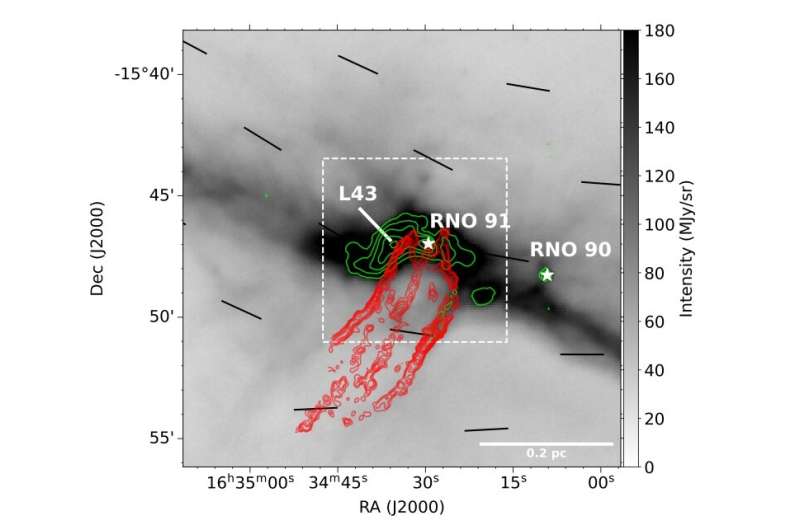May 29, 2023 report
This article has been reviewed according to Science X's editorial process and policies. Editors have highlighted the following attributes while ensuring the content's credibility:
fact-checked
preprint
trusted source
proofread
Observers inspect complex magnetic field of the molecular cloud Lynds 43

Using the James Clerk Maxwell Telescope (JCMT), an international team of astronomers has observed a nearby molecular cloud designated Lynds 43. Results of the observations, published May 18 on the arXiv pre-print server, provide more hints into the complex magnetic field of this cloud.
Lynds 43, or L43 for short, is a dense and complex molecular cloud in the northern part of the Ophiuchus star-forming region, at a distance of about 400 light years. The cloud contains a bright starless core embedded within a longer more diffuse filament, a T-Tauri star (designated RNO 90) and a young Class I protostar (RNO 91). Previous studies of L43 have found that it has a large-scale magnetic field roughly parallel to the filament, although curving slightly to the south.
A group of astronomers led by Janik Karoly of the University of Central Lancashire, U.K., has performed polarization observations of dust emission from L43 as part of the B-fields In STar Forming Regions Observations (BISTRO) large survey program. For this purpose, they employed JCMT's Submillimetre Common-User Bolometer Array 2 (SCUBA2)/POL-2.
"We presented polarization measurements of the infrared dark molecular cloud L43 at 850 µm made using JCMT/POL-2 as part of the JCMT BISTRO Survey," the researchers wrote in the paper.
The observations of L43 found molecular hydrogen (H2) column densities typical for dense starless cores, and a power law index of about -0.85. Therefore, the results suggest a possible decrease, but not complete loss, in grain alignment efficiency, deep within the molecular cloud.
Furthermore, the study identified a complicated and multiple-component magnetic field of L43, which was divided into three regions. One region is slightly offset from the dense submillimeter-bright core (Region 2), another region in the more diffuse region to the east (Region 1) and the remaining region which spatially coincides in the plane of the sky with the carbon monoxide outflow driven by RNO 91.
The observations also found an alignment between the magnetic field and the outflow cavity walls which is distinctly different from the magnetic field in the rest of the cloud. Based on the collected data, the magnetic field strengths in Region 1 and Region 2 were calculated to be about 40–90 µG and 70–160 µG, respectively. The magnetic field strength in the outflow region is estimated to be between 120 and 260 µG.
The authors of the paper added that there appears to be an evolutionary gradient along the isolated filament that L43 is embedded within. The gradient starts with the most evolved source RNO 90 which is closest to the Scorpius–Centaurus stellar association (Sco OB2) and moving away from this association towards RNO 91 and then eventually the starless core.
More information: Janik Karoly et al, The JCMT BISTRO Survey: Studying the Complex Magnetic Field of L43, arXiv (2023). DOI: 10.48550/arxiv.2305.11306
Journal information: arXiv
© 2023 Science X Network





















